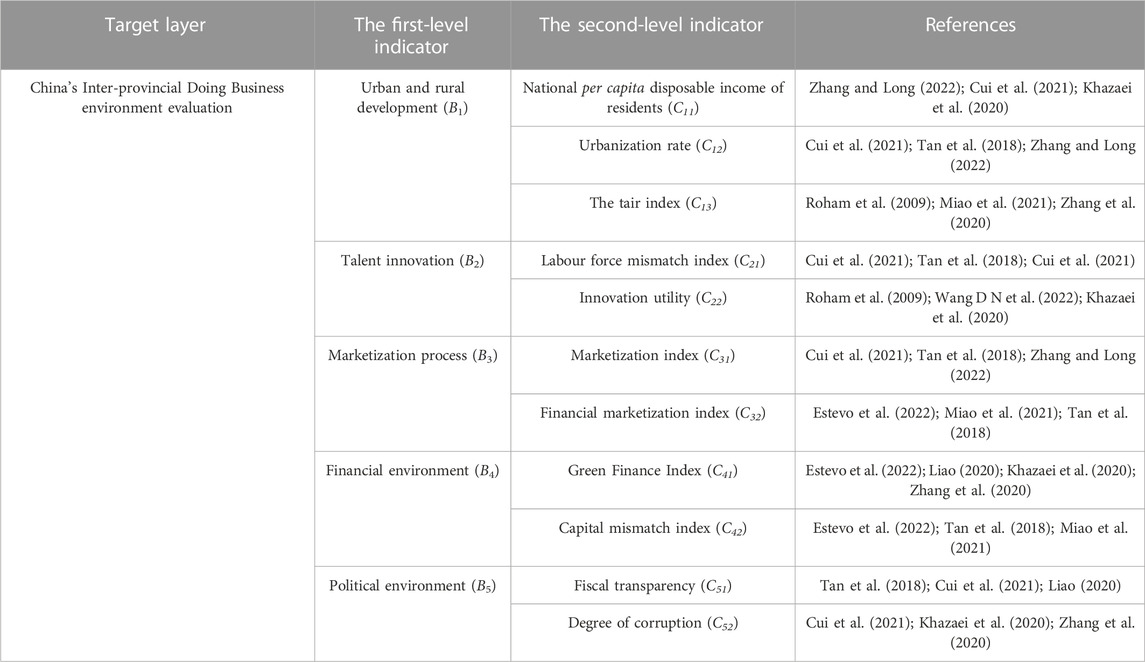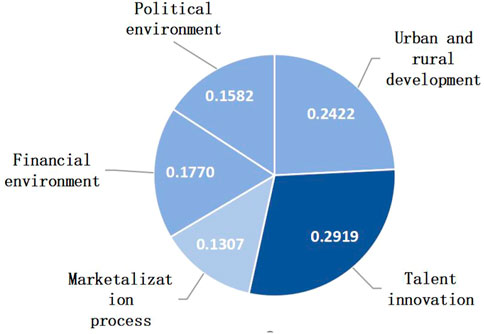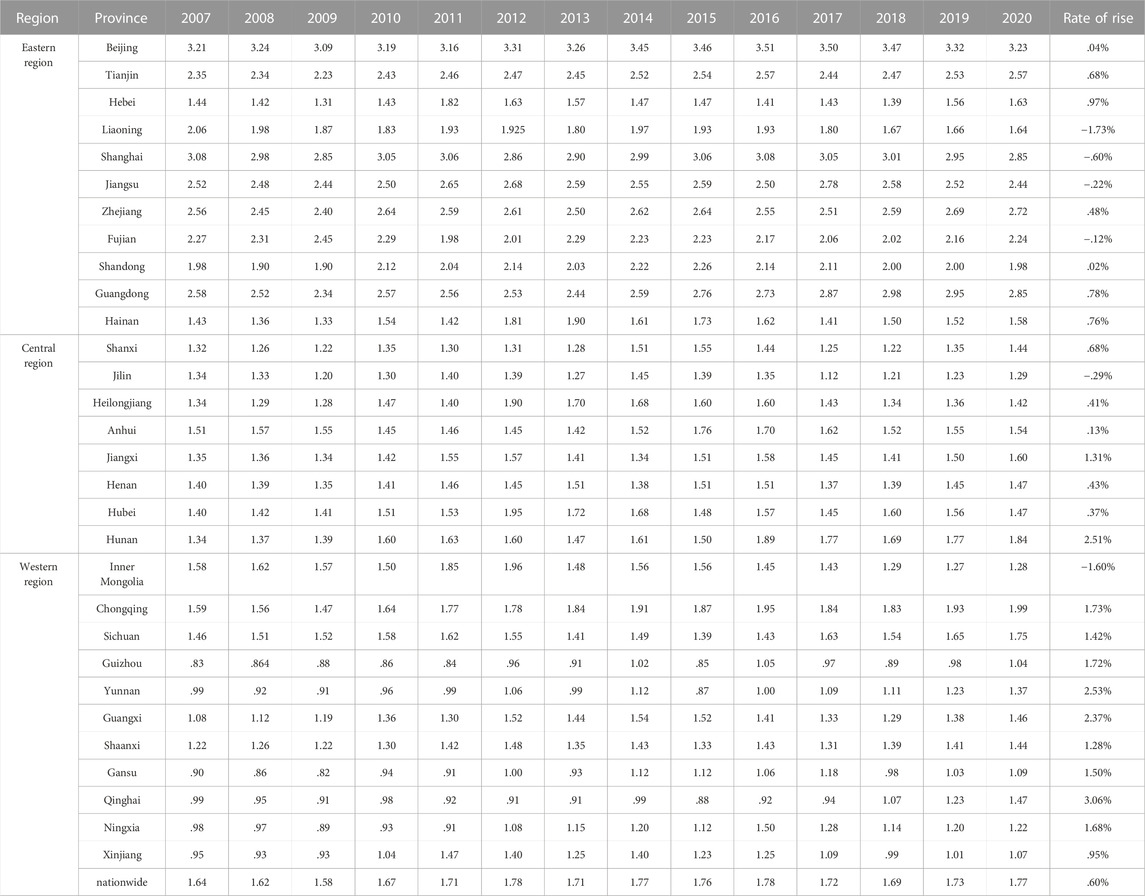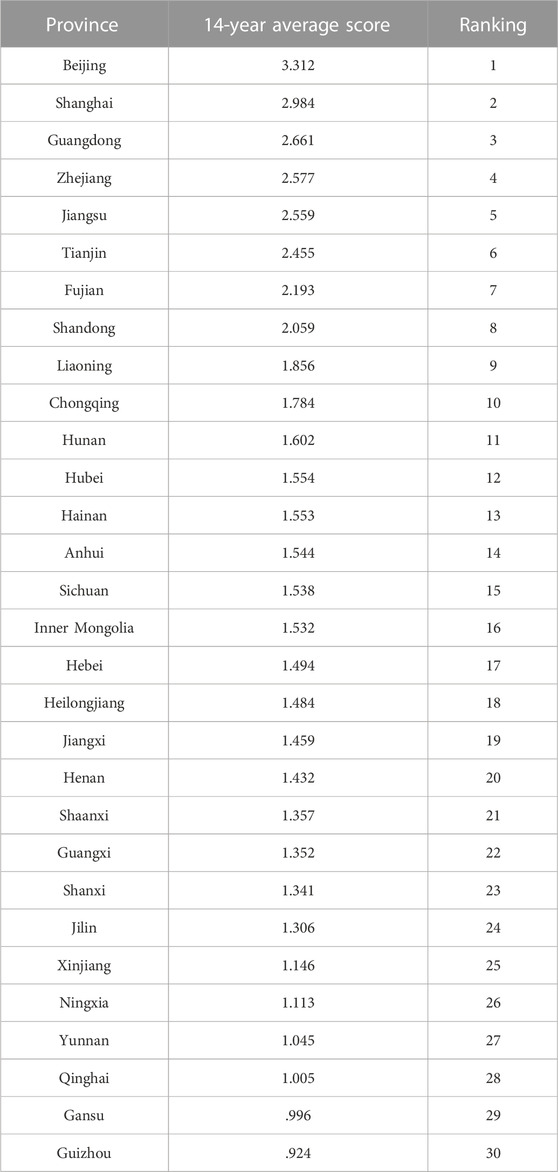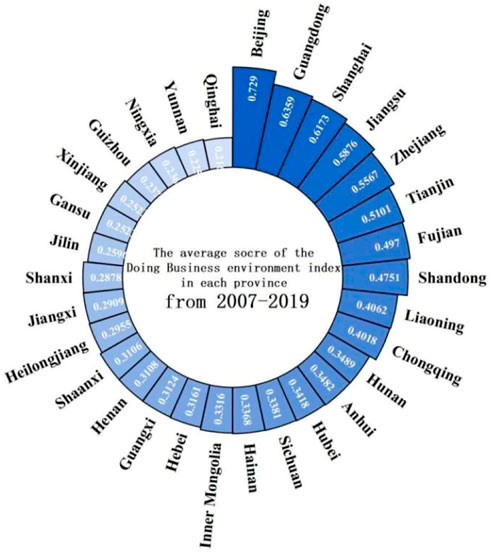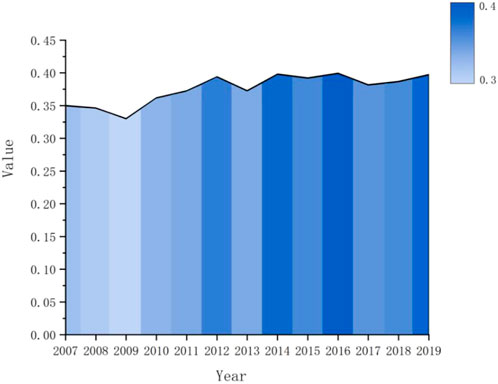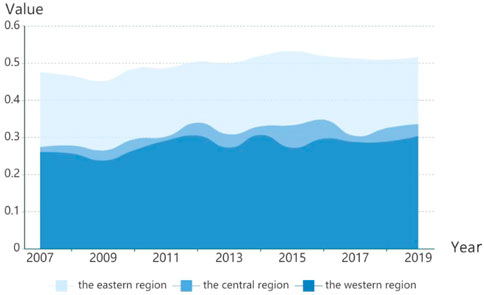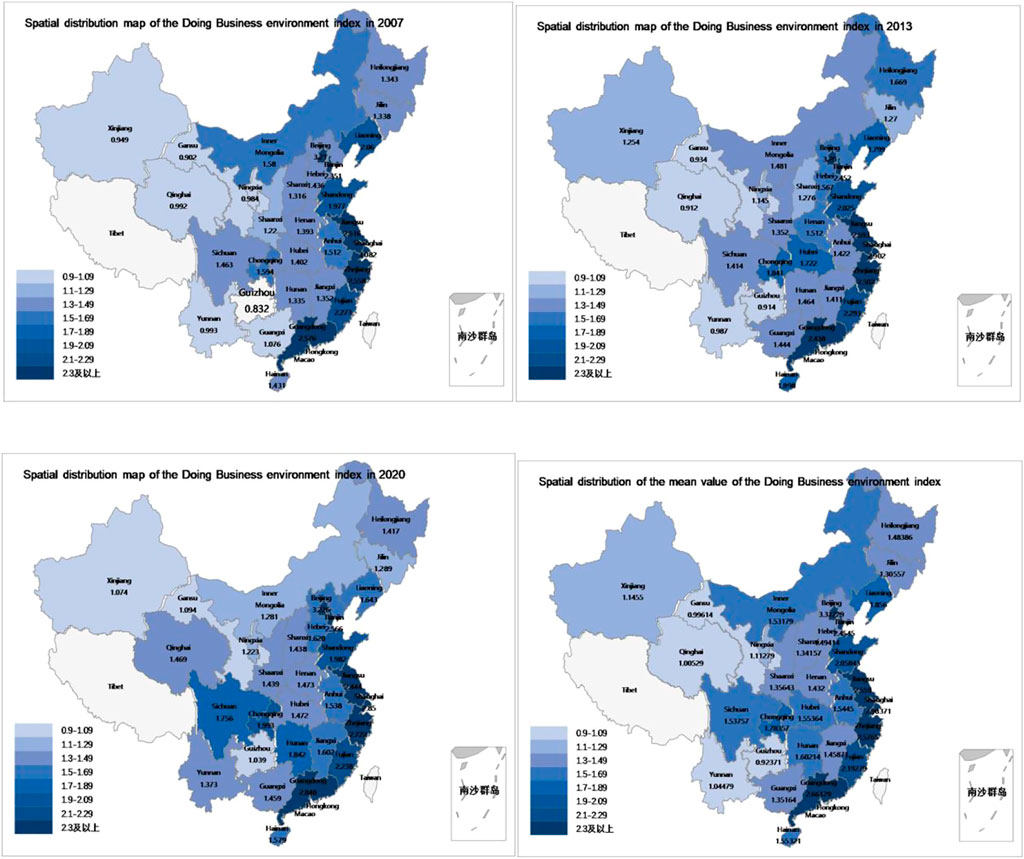- 1Zhejiang Business Technology Institute, Ningbo, China
- 2School of Statistics and Mathematics, Zhejiang Gongshang University, Hangzhou, China
- 3School of Business, Ningbo University, Ningbo, China
- 4Department of Mathematics, Riphah International University, Lahore, Pakistan
Introduction: The Doing Business environment affects the operation of enterprises in the region and exerts an important impact on economic development, taxation, and employment.
Methods: According to the characteristics of large differences in the level of economic development between provinces in China, this study builds a set of scientific and reasonable evaluation index systems of inter-provincial Doing Business environment, including five first-level indicators and 11 second-level indicators. Moreover, this study constructs a comprehensive evaluation model based on the Entropy-CoCoSo framework and explores its application in China’s inter-provincial Doing Business environment evaluation.
Results: Based on China’s provincial panel data from 2007 to 2020, the research found that the Doing Business environment of each province has generally improved in recent years, but the inter-provincial differences are more prominent. The western provinces have obvious late-mover advantages.
Discussion: Finally, we put forward several targeted suggestions, providing a powerful reference for optimizing China’s Doing Business environment and promoting high-quality economic development.
1 Introduction
A sound Doing Business (DB) environment indicates an important symbol of the economic soft power of a country or region. In the latest Doing Business 2020 released by the World Bank, China’s DB environment ranks 31st in the world, entering the global top 40 for the first time. In 2017, at the 16th meeting of the Central Financial and Economic Leading Group, General Secretary Jinping Xi pointed out that a stable, fair, transparent, and efficient DB environment should be created. In November 2018, Jinping Xi said at the opening ceremony of the first China International Import Expo, “An international first-class DB environment should be created”. The quality of the DB environment directly affects the operation of enterprises in the region, related to the stimulation of market vitality, and exerts an important impact on economic development, taxation, and employment. Optimizing the DB environment significantly affects the soft power and comprehensive competitiveness of a region or country, and is effective in promoting economic transformation and upgrading. However, at present, there is a lack of a set of scientific and reasonable evaluation systems to reflect the development of China’s existing DB environment at the province level. The existing DB environment evaluation system mostly is overwhelmingly focused on the city level or based on the World Bank (2003) from the micro-enterprise level, while the provincial DB environment index evaluation system is less, and evaluation studies covering all provinces are rare. Although the existing DB environment index evaluation system based on the city level or enterprise level can provide a reference for the leaders or decision-makers to improve local business conditions and business management, it’s difficult to take a global perspective to optimize China’s business environment from the top-level design and provide a reference for inter-provincial balanced development.
Therefore, departing significantly from the conventional method to the study of DB environment focusing on micro-enterprise or city level, this study aims to construct an evaluation index system in line with the inter-provincial DB business evaluation in China, allowing for better assessment of economic and investment growth at the province level. The changes in China’s environment are also analyzed through time and space dimensions by using a novel evaluation framework, and then the development ideas are clarified to provide a reference basis for further optimization of China’s DB environment. The proposed system index can provide insights from a more complete framework that approximates the actual development of competitiveness and investment. Therefore, the government can get clues from the system and determine a series of possible provinces according to their unique advantages.
The remainder of this study is structured as follows: In Section 2, we present a brief literature review on DB environment. In Section 3, we present a novel inter-provincial DB environment evaluation index system. We propose the Entropy-CoCoSo evaluation framework for DB environment in Section 4. Section 5 carries out the tpatial-temporal differences analysis of inter-provincial DB environment in China, including the indicators used, data sources, and how the weight of index is calculated. We explore the findings and present several recommendations in Section 6. Finally, we conclude with a brief discussion of research limitations and future directions in Section 7.
2 Literature review
Domestic and foreign scholars have rich research on the evaluation of the DB environment. Among them, the main and widely recognized one is the inter-country DB environment indicators system established by the World Bank from the perspective of enterprises, including 10 first-level indicators and 43 second-level indicators, based on ten aspects of the DB environment (Starting a business, Dealing with construction permits, Getting electricity, Registering property, Getting credit, Protecting minority investors, Paying taxes, Trading across borders, Enforcing contracts) (World Bank, 2003). The World Bank’s annual report on the DB environment of various countries is widely adopted by countries because of its authoritativeness and is used as a reference for improving the business environment. Its reports directly or indirectly affect the willingness of investors to invest in the world (Song and He, 2018). Tan et al. (2018) presented a novel index to assess the ease of DB at the sub-national level. Roham et al. (2009) developed a new systematic method employing fuzzy set theory to generate composite indicators of DB environment for assessment and classification problems. Estevo et al. (2022) assessed the relationship between the variables related to the business environment and informality. Khazaei and Azizi (2020) found a positive correlation between business environment indicators and corporate financial performance.
In recent years, with the continuous development of China’s economy, more and more scholars have begun to study China’s DB environment. Zhang and Long (2022) constructed the evaluation index system of the DB environment in Chinese cities based on the seven dimensions of the government environment and analyzed the realization path of the business environment in the development of the urban tourism industry in China. Miao et al. (2021) presented a business environment evaluation index system consisting of six primary and 33 secondary indicators to optimize the business environment while promoting economic development. Cui et al. (2021) empirically analyzed the impact of the DB environment on economic growth using the DB simplicity scores from the World Bank’s Doing Business 2004–2018 project. Wang D. Z. et al. (2022) analyzed the interaction between the business environment, agricultural openness, and high-quality agricultural economy from the perspective of Chinese provinces and find that there is a quantitative interaction between them with significant long-term time effects. By examining the pattern of administrative reform in the Chinese context, Liao (2020) found three main paths to optimize the business environment: balanced development, reform-oriented and resource-driven.
As mentioned earlier, the indicators of the DB environment are vital to the overall understanding and assessment of national business development, and strategy formulation for business regulations and policy. There are now 30 provinces, municipalities, and autonomous regions in China, but their business environment construction level is very different. Judging from the situation of each province and region, the eastern coastal provinces have a good business environment, followed by the central region, and the western provinces are the worst. Thus, the provincial DB environment analysis was indeed useful, and it is necessary to combine China’s national conditions to construct an inter-provincial Doing Business environment evaluation index system.
3 Evaluation index system of China’s inter-provincial DB environment
The DB environment is an organic and dynamic system, which includes political, economic, social, and cultural factors. Based on the research of the existing DB environment evaluation index system, combined with representation, operability, and practicality, this paper selects five aspects that can best reflect the development of the provincial DB environment, namely, urban and rural development, talent innovation, marketization process, financial environment, and political environment.
(1) Urban and rural development. The imbalance between urban and rural development is a remarkable feature of China’s economic and social development, which is directly related to the evaluation of the overall regional DB environment. Coordinating the integrated development of urban and rural areas, optimizing the DB environment of towns and towns, and introducing supporting policies to encourage enterprises to invest in towns will not only help narrow the gap between urban and rural areas, improve the urbanization rate and promote regional economic development but also form a positive feedback mechanism to make the DB environment develop in a better direction.
(2) Talent innovation. Talent and innovation are the two basic elements for enterprises to realize innovation-driven development. On the one hand, talents are the main body of innovation and entrepreneurship, and the subject of enterprise operation. The creation of a first-class DB environment cannot be achieved without talent. On the other hand, a good innovation environment is conducive to the update and iteration of technology. “Science and technology is the primary productive force”. Technological innovation can significantly improve the production efficiency of enterprises, promote the better development of enterprises, and at the same time promote the overall development of the local economy. The DB environment can also be optimized, forming a virtuous cycle.
(3) Marketization process. “Marketization means that we must remove unreasonable institutional barriers and further stimulate the market vitality and social creativity.” This is what Chinese Premier Keqiang Li mentioned in a national teleconference. With the rapid economic development and the continuous progress of marketization, various market entities are constantly emerging, especially the vitality of the private economy. Stimulating the vitality of various market entities is an important part of improving the DB environment.
(4) Financial environment. The financial environment is the soil for enterprises to carry out capital management, risk control, investment activities, and financing activities. The optimization of a good financial environment plays a decisive role in the improvement of the DB environment. The daily operation and orderly development of enterprises need the support of capital, ensure the correct allocation of funds, and vigorously develop green finance, which will help to provide strong support for enterprises, and better serve the high-quality development of the economy and society.
(5) Political environment. At the Fifth Plenary Session of the 19th CPC Central Committee, it was proposed to “uphold and improve the basic socialist economic system, give full play to the decisive role of the market in resource allocation, better play the role of the government, and better integrate the effective market with the effective government”. Strong government intervention in the market is a distinctive feature of China’s economy. The slightest change in the political environment is related to the operation of enterprises, and the registration, approval, production, and sales of enterprises are all completed under the supervision of the government. A relaxed political environment, and a transparent, clean, and promising government, is crucial to the optimization of the DB environment.
According to the above index construction logic, in this study we established China’s inter-provincial DB environment index evaluation system, consisting of five first-level indicators of urban and rural development, talent innovation, marketization process, financial environment, and political environment. 11 most representative indicators are the second-level indicators, as shown in Table 1.
4 Entropy-CoCoSo evaluation framework for DB environment
Scholars have applied many methods to measure the level of DB environment, mainly including Analytic Hierarchy Process (AHP) method (Randelovic et al., 2020), Equalization method (Hajduova et al., 2020), Principal Component Analysis method (Borojo and Jiang, 2020), TOPSIS (Hajduova et al., 2020; Wang et al., 2020) and fuzzy linguistic (Roham et al., 2009). However, the weights of indicators are given by experts in advance in most existing research, which has a strong subjectivity according to experts’ preferences (Tan et al., 2018). In fact, determining the relative degrees of importance of each indicator objectively is a significant challenging problem. Moreover, the evaluation methods used are relatively simple and traditional among the existing theoretical research, which have some inherent defects. Therefore, we aim to propose a novel multi-criteria decision-making (MCDM) model for the evaluation of the DB environment, namely the Entropy-CoCoSo framework. In the proposed Entropy-CoCoSo evaluation framework, the weight of each index is determined by the entropy method, and the comprehensive evaluation of the Doing Business environment of each province is realized by the combined compromise solution (CoCoSo, Yazdani et al., 2019a) method.
4.1 Index weight based on entropy method
Originally applied to thermodynamics in physics to reflect the degree of system chaos, the entropy method is now widely used in project evaluation and social-economic research. The basic idea of the entropy weight method is to determine the corresponding objective weight referring to the index variability. The greater the uncertainty, the greater the information entropy, which is directly proportional to the information entropy (Ren et al., 2021; Wang X. et al., 2022). The smaller the information entropy of the index, the greater the degree of variability of the indicator, the more information provided, and the greater the role it can play in the comprehensive evaluation, then the greater its weight.
The entropy method can exclude the interference of subjective factors, and objectively and accurately calculate the weight of each index with higher credibility (Ren et al., 2019; Zeng et al., 2020). To reflect the situation of China’s inter-provincial DB environment reasonably and accurately, this study uses the entropy method to calculate the weight of each indicator. The main steps are as follows:
(1) Construct the evaluation matrix. Let
(2) Data standardization processing. Since different indicators have different dimensions and units, it is necessary to standardize the indicator assessment. Let the value of each indicator data be
For negative indicators:
Then the evaluation matrix
(3) The proportion of each index value, that is, the proportion
(4) Find the information entropy of each indicator. According to the definition of information entropy, the information entropy of the
where
(5) Calculate the weight of each index
Apparently, we have
4.2 Evaluation process based on Entropy-CoCoSo framework
The CoCoSo approach is a comprehensive model that uses arithmetic weighting and geometric weighting to handle MCDM problems (Yazdani et al., 2019b). Its main idea is to use three different metrics (aggregation strategy) to measure the relative importance of each alternative and rank all alternatives according to their relative importance. Combining three evaluation score strategies to make the final decision results more reasonable and superior, which not only avoids the problem of biased results caused by a single decision method but also effectively integrates multiple aggregation ideas to achieve internal balance and thus weakens the variability of decision results. Now the CoCoSo method is widely used in different areas, such as blockchain platform selection (Lai et al., 2022), logistics center site selection (Ulutas et al., 2020; Banihashemi et al., 2021), supplier selection (Yazdani et al., 2019b; Lai et al., 2020; Wang C. N. et al., 2022; Wei et al., 2022) due to its high flexibility and simple calculation.
Considering that no studies have used the technique to handle out the DB environment evaluation issue, this paper presents the Entropy-CoCoSo evaluation framework by integrating the idea of the importance of different indicators, and its main steps are as follows:
(1) Obtain the standardized decision matrix
(2) Calculate the arithmetic weighted sum:
(3) Calculate the geometric weighted sum:
(4) The relative importance of the alternative
where
(5) The comprehensive evaluation index of each alternative
(6) Sort the alternatives according to the comprehensive score (
5 Spatial-temporal differences analysis of inter-provincial DB environment in China
To better improve the business environment, the Chinese government has implemented reforms to accelerate enterprise registration and trading, improve the credit mechanism and strengthen investor protection since 2007. The newly revised Company Law has shortened the time required to register an enterprise from 48 days to 35 days, and lowered the minimum capital required, greatly facilitating the establishment of new enterprises. The revision of the Company Law has strengthened the supervision of insider trading and increased the protection of investors. The newly adopted online customs declaration procedure has shortened the customs clearance time of import and export by 2 days, which is conducive to improving the international competitiveness of import and export enterprises. Next, the proposed evaluation index system and Entropy-CoCoSo framework are constructed to measure and evaluate China’s inter-provincial DB environment from 2007 to 2020.
5.1 Data source
(1) National per capita disposable income of residents and urbanization rate. The relevant data are derived from the “China Statistical Yearbook”, the statistical yearbooks of provinces, municipalities, and autonomous regions over the years, and some of the missing data were obtained by the Interpolation method.
(2) Capital mismatch and labor force mismatch. Hsieh and Klenow (2009) and Aoki (2012) put forward the theoretical framework of factor mismatch measurement from the enterprise level, industry level, and national and regional macro level respectively. In this paper, we combine the above theoretical framework and refer to the relative mismatch measurement model of factors proposed by Chen et al. (2011), and present the following model:
where
According to the model, when
(3) Innovation utility. The comprehensive score of the provincial-level “Comprehensive Utility Value of China’s Regional Innovation Capability” in the “China Regional Innovation Capability Evaluation Report” jointly issued by the China Science and Technology Development Strategy Group and the Chinese Academy of Sciences over the years is used as the proxy variable for the regional innovation level of the explained variable. “World Competitiveness Yearbook”, “Global Innovation Index”, “Global Competitiveness Report”, “Innovative Alliance Index”, “National Innovation Index” and other well-known international and domestic reports, and measured according to China’s regional characteristics and characteristics, the comprehensive score is the innovation utility, and some missing data were obtained by interpolation.
(4) Green finance index. This paper divides the green financial system into four modules: green credit, green investment, green insurance, and government support, and forms an indicator system based on this, which in turn constitutes a comprehensive measurement system for the level of green financial development. To avoid the subjectivity of the traditional expert weight scoring, this paper adopts the entropy weight method to objectively assign the weight of the index. Then, the green finance index of 30 provinces in mainland China from 2007 to 2020 is measured, and some missing data are obtained by interpolation. The relevant data came from the “China Statistical Yearbook”, the statistical yearbooks of provinces, municipalities, and autonomous regions over the years, and the “China Insurance Yearbook”.
(5) Financial marketization index. As for the measurement of the financial marketization index, this paper refers to the “marketization index of the financial industry” expressed in the “China’s Marketization Index - Annual Report on the Relative Progress of Marketization in Various Regions” as the agent variable for financial marketization. Secondly, considering that the current version of the book has adjusted the calculation base period compared with the 2011 version, there are no statistics on the financial marketization index in the central region. Therefore, referring to the method of Zhong et al. (2020), this paper utilizes the deflator index method and the interpolation method to adjust the data, and finally obtains the sample data of the core explanatory variable of this paper, that is, the financial marketization index.
(6) Marketization process. The marketization process refers to the research of Xiao and He (2015), and selects the marketization index to represent the marketization process of the region. Some missing data were obtained by interpolation method, and the data used were all from the “China Statistical Yearbook”, “China Marketization Index” and the statistical yearbooks of various provinces and cities.
(7) Fiscal transparency. The comprehensive score of “China’s Fiscal Transparency Report - Evaluation of Provincial Fiscal Information Disclosure” issued by the Shanghai University of Finance and Economics, which is currently the most authoritative in China, is used as its proxy variable, and some missing data are obtained by interpolation.
(8) The degree of corruption. The degree of corruption is calculated by the number of cases/the total number of public officials, and some missing data is obtained by the Interpolation method. The relevant data are derived from the “China procurator Yearbook”.
5.2 Index weight calculation
Based on the panel data of 30 provinces, municipalities, and autonomous regions in China from 2007 to 2020, the weights of 11 second-lever indicators and five first-lever indicators are determined, the results are shown in Table 2.
As can be seen from Table 2, talent innovation accounted for 32.54%, urban and rural development status accounted for 31.63%, marketization process accounted for 20.24%, financial environment and political environment accounted for 8.39% and 7.2% respectively, all less than 10%. It shows that in the process of inter-provincial Doing Business environment comparison, there is a great difference between talent innovation data and urban and rural development status data, the data on the marketization process is quite different among provinces, and the data on the financial environment and political environment is relatively small. It basically conforms to the characteristics of unbalanced development among China’s regions. The eastern region has a high degree of economic development, and the overall development of urban and rural areas is relatively good. Most of the talents are concentrated in the eastern region with strong innovation capabilities. After years of development, the marketization process is also significantly better than in the central and western regions. The development of the central and western regions is relatively general, the urban and rural development conditions are poor, and the gap is large, and the talents flow from the central and western regions to the eastern region. The lack of talent leads to insufficient innovation ability, and the lack of development efforts and short development time lead to a lag in the marketization process. Although there are certain gaps in the inter-provincial data of financial environment and political environment indicators, they are not as significant as urban and rural development, talent innovation and marketization.
To fully show the different importance among the first-level 5 indicators, it is specially presented in the form of a radar map, as shown in Figure 1.
5.3 Inter-provincial DB environment evaluation
Based on the weights of indicators obtained in Section 5.2, the business environment of 30 provinces, municipalities, and autonomous regions in China from 2007 to 2020 was evaluated by utilizing the CoCoSo method. Two different aggregation processes (arithmetic weighting, and geometric weighting) and three evaluation scoring strategies are integrated to measure the relative importance, that is, the comprehensive evaluation index score of the DB environment of each province in different years
According to the results obtained in Table 3, the average scores of each province from 2007 to 2020 were calculated and sorted from high to low. The results are shown in Table 4 and Figure 2.
To fully show the changes in the national DB environment development, a line chart is drawn, shown in Figure 3.
The above results show that, at the national level, the score of China’s DB environment has increased from 1.635 in 2007 to 1.767 in 2020, with an average annual growth rate of .6%. The index score shows an upward trend, indicating that China’s DB environment is generally optimized, in line with the strategy of “optimizing the DB environment” vigorously advocated by the state in recent years. However, the score of China’s DB environment does not increase year by year but shows a fluctuating upward trend. This is because China’s business environment is not only affected by the domestic economy, politics, and other aspects, but also by the world economic situation, global politics, and many other external factors. With the further deepening of globalization, the impact of “globalization” on China’s DB environment has both advantages and disadvantages. When a global economic crisis occurs, China’s DB environment will inevitably be affected by it. Due to the increasingly frequent exchanges of funds, talents, and technologies between China and other countries in the world, it is conducive to China’s economic development and the optimization of the business environment. At present, China is gradually changing the way it participates in economic globalization, actively promoting and building a more inclusive economic globalization (Xia et al., 2020).
From the perspective of provinces, the scores of Beijing, Shanghai, Guangdong, Zhejiang, Jiangsu, and Tianjin were always greater than two during the 14 years from 2007 to 2020. In terms of environmental ranking, the above six provinces can be identified as the six provinces with the best DB environment in China, followed by Fujian, Shandong, and Chongqing. Further analysis of the data shows that the top ten provinces in terms of DB environment are concentrated in the eastern region, the provinces ranked ten to twenty are concentrated in the central region, and the provinces ranked twenty to thirty basically belong to the western region. From 2007 to 2020, the DB environment of most provinces showed a fluctuating upward trend overall. Some of them experienced large inter-annual changes, and a very small number of provinces experienced negative growth in the DB environment. The major reason for the large inter-annual fluctuations in the province is the violent fluctuations in the talent innovation and political environment of the province. From a deeper level, the behavioral factors, and personnel changes of government officials in each province will have a significant impact on the business environment. The quality of their governance capabilities directly or indirectly affects the province’s attraction to outstanding talents and affects innovation capabilities. At the same time, the personnel of provincial officials Changes, and the length of official tenure can affect the disclosure of financial information, which in turn affects the business environment.
To further reveal the spatial and temporal differences in the regional DB environment in China, next we study and calculate the scores of the DB environment of the three geographical regions, shown in Table 5 and Figure 4.
To better illustrate the spatial differences in China’s DB environment and the changes in recent years, the spatial and temporal distribution map of China’s DB environment is hereby drawn, as shown in Figure 5.
According to the above chart, the DB environment in China’s three regions shows a significant distribution pattern of “East over West”. But without exception, they all show a trend of continuous improvement. The Doing Business environment index score of the eastern region has increased from 2.315 in 2007 to 2.339 in 2020, and the DB environment index score of the central region has increased from 1.374 in 2007 to 1.509 in 2020. The DB environment index score in the western region increased from 1.164 in 2007 to 1.413 in 2020.
In addition, the index score is analyzed, and the index score is generally divided into three intervals, the comprehensive evaluation index
All the above characteristics show that the DB environment is completely consistent with the degree of economic development. The eastern region has strong comprehensive economic development strength, a high urbanization rate, early opening to the outside world, and has always been in the vanguard of the domestic DB environment reform wave. Due to its proximity to the eastern region, the central region is easily affected by the radiation effect of the eastern region, and its urban and rural development, talent innovation, marketization process, financial environment, and political environment are better than those in the western region. However, the western region is limited by the natural environment, capital, and other conditions, the industry is backward, and the economy is mainly resource-consuming. Although in terms of index scores and various dimensions of indicators, the eastern region is better than the central and western regions, the average annual growth rate of the index scores in the central and western regions is higher than that of the eastern region, which has obvious late-mover advantages, and the growth potential is not enough. We should accelerate the implementation of measures to optimize the DB environment in the central and western regions.
6 Policy recommendations
Based on the above analysis concerning the DB environment of each province in terms of spatial and temporal differences, it is found that the overall environment of various provinces has generally improved in recent years, but the inter-provincial differences are still relatively significant. As a result, this paper makes the following recommendations:
(1) Adhere to the centralized and unified leadership of the central government for steady and effective implementation in all localities and insist on inquiring about politics. Optimizing the business environment is a struggle to correctly handle the relationship between the government and the market, but also a self-revolution on the concept of government, systems and mechanisms, and management techniques. At the same time, the construction of the business environment is an important task that spans all aspects of economic, political, social, cultural, and ecological construction. Therefore, to do a good job in the construction of the business environment, we must give full play to the leading role of the central government in overseeing the overall situation and coordinating all parties to build social consensus. Regional inspection and supervision efforts are made to create a clean and upright political ecology. At the same time, provinces and municipalities across the country should closely follow the pace of the central government, deepen their understanding of policy orientation, and actively and effectively implement the “Regulations on Optimizing the Business Environment” promulgated by the Party Central Committee and the State Council, formulate, and improve the evaluation system, conduct regular evaluations, and fully solve problems for local enterprises. In addition, both the central government and all localities are supposed to insist on inquiring about politics, thinking about problems, handling things, and formulating policies from the perspective of the masses and enterprises, so as to improve the pertinence and effectiveness of the business environment reform policies.
(2) Strengthen inter-regional exchanges and cooperation and promote coordinated and integrated development. The DB environment of provinces has improved in recent years, but the inter-provincial differences are prominent, and the inter-provincial DB environment shows a significant “valuing the east over the west” distribution pattern, it is recommended to strengthen exchanges and cooperation between the eastern and central and western regions and provide targeted assistance. As the eastern region of China has a first-mover advantage in economic development, its economic development has reached a certain extent, and the DB environment has also been significantly improved. Therefore, the eastern region should continue to give full play to its geographical advantages, further optimize the Doing Business environment, and make it the engine of China’s economic transformation and development. However, due to the urban and rural development status, talent innovation, marketization process, financial environment, and political environment in the central and western regions all lag behind the eastern region, the central and western regions need to introduce corresponding measures in combination with their own development model to make up for the deficiencies in the above fields. At the same time, all regions should actively respond to national strategies such as “the rise of central China” and “western development”, strengthening cooperation and exchanges, and achieving mutual benefit and win-win results in the eastern, central, and western regions. Specifically, the central and western regions should rely on the policy advantages and the human resources, social capital and technological advantages of the eastern regions to seize the development opportunities, vigorously support industrial development, and promote the optimization and transformation of local enterprises and industrial structure, so as to optimize the local DB environment.
(3) Accelerate the coordinated development of urban and rural areas and increase support for talent training and technological innovation. Based on the characteristics of urban and rural development and talent innovation occupying an important position in the inter-provincial DB environment evaluation system, this paper suggests that the coordinated development of urban and rural areas should be accelerated to increase the support for talent training and investment in scientific and technological innovation. Urbanization is the only way to modernization and an important way to achieve common prosperity, which is of great significance for solving the principal contradiction of Chinese society, promoting economic quality development, and increasing people’s income. It is also strong support to narrow the gap between regional development and cannot be ignored for expanding domestic demand and promoting the transformation and upgrading of industrial structure. Therefore, the key to promoting urban and rural coordinated development is to realize urbanization in rural areas. In addition, the competition today is, in the final analysis, the competition of talents, which is the first resource of the country and society, and the most important resource and driving force for technological progress and economic and social development. Which province attracts and gathers more excellent talents means that it occupies the initiative in the development and can form a relatively strong position in the fierce scientific and technological and economic competition.
(4) Accelerate the transformation of the government to a service-oriented government, and vigorously promote the market-oriented process. Based on the research, although the influence of the marketization process in the evaluation of the inter-provincial business environment is not as great as that of urban and rural development and talent innovation, it is equally important. The process of marketization process depends to a large extent on the local government, so it is necessary to straighten out the functions and boundaries of the government in managing the economy, reshape the internal mechanism and process of the government, and regulate and restrain the government to drive the market to be effective, the enterprises to benefit, and the people to benefit, and to promote the transformation of government into a service-oriented government which makes it play its role as a public servant for economic development, while adhering to the market-oriented, in-depth promotion of market-oriented reforms, maintaining an efficient market-oriented operation system, stimulate the vitality and social creativity of various market entities. Give full play to the decisive role of the market in resource allocation, promote the rational flow and distribution of capital and labor, reduce the degree of mismatch, and further improve market efficiency. In addition, it is necessary to deepen the reform of “Streamline administration and delegate power, improve regulation, and upgrade services”, and further strengthen innovation supervision. Adhere to the combination of delegating power and regulation, consolidate supervisory responsibilities, and improve the supervision mechanism of the whole chain and the whole process before and after the event. Improving open, transparent, concise, and clear regulatory rules and standards.
7 Conclusion
Considering the actual development situation of China, standing from the macro level, this study first constructed a suitable inter-provincial Doing Business environment index system for China’s current economic transition, including five first-level indicators and 11 second-level indicators. This evaluation system departs significantly from conventional methods focusing on DB environment development from the city level or micro-enterprise level, offering an alternative to current popular evaluation systems of DB at the provincial level. Moreover, this study constructs a novel comprehensive evaluation framework based on entropy weight and the classic CoCoSo method, wherein the entropy method is used to determine the objective weight of the selection indicators, and the CoCoSo is applied to comprehensive scores of China’s inter-provincial DB environment. Based on China’s provincial panel data from 2007 to 2020, the study found that the Doing Business environment of each province has generally improved in recent years, but the inter-provincial differences are more prominent. The western provinces have obvious late-mover advantages. Finally, several corresponding suggestions are then put forward to provide a reference for decision-makers to optimize China’s overall DB environment.
There are several methodological issues that need to be highlighted. First, the proposed framework contains 11 indicators, which are relatively simple and easy to manage at the provincial level. We can further expand or add some other relevant indicators in the subsequent use to make them more comprehensive, which may be a potential field for future research. Second, owing to its usefulness and effectiveness, the popular CoCoSo method was applied to measure the development of DB environment in this study. But nevertheless other methods thought needs to go into the consideration regarding the evaluation of DB environment as a typical MCDM, such as the BWM, and EDAS (Zhang et al., 2022; Zeng et al., 2023). Third, a classic issue of establishing an index is to determine how importance should be assigned to the different situations. In this case, we have opted to utilize the entropy method to identify the objective weights of indicators. Our research seems to be objective and empirical manner, but nevertheless, more thought needs to go into the consideration regarding the allocation of weights using a more subjective manner by considering the people’s subjective judgment, such as AHP (Saaty, 2006) and social network trust method.
Data availability statement
The original contributions presented in the study are included in the article/supplementary material, further inquiries can be directed to the corresponding author.
Author contributions
Writing—original draft preparation, YZ and ZL; writing—review and editing, SZ; methodology, KU; supervision, SZ. All authors have read and agreed to the published version of the manuscript.
Funding
This work is supported by the National Social Science Fund of China (21BGJ034), Social Sciences Planning Projects of Zhejiang (21QNYC11ZD) and Statistical Scientific Key Research Project of China (2021LZ33).
Conflict of interest
The authors declare that the research was conducted in the absence of any commercial or financial relationships that could be construed as a potential conflict of interest.
Publisher’s note
All claims expressed in this article are solely those of the authors and do not necessarily represent those of their affiliated organizations, or those of the publisher, the editors and the reviewers. Any product that may be evaluated in this article, or claim that may be made by its manufacturer, is not guaranteed or endorsed by the publisher.
References
Aoki, S. (2012). A simple accounting framework for the effect of resource misallocation on aggregate productivity. J. Jpn. Int. Econ. 26 (4), 473–494. doi:10.1016/j.jjie.2012.08.001
Banihashemi, S. A., Khalilzadeh, M., Zavadskas, E. K., and Antucheviciene, J. (2021). Investigating the environmental impacts of construction projects in time-cost trade-off project scheduling problems with CoCoSo multi-criteria decision-making method. Sustainability 13 (19), 10922. doi:10.3390/su131910922
Borojo, D. G., and Jiang, Y. S. (2020). The impacts of institutional quality and business environment on Chinese foreign direct investment flow to african countries. Econ. Research-Ekonomska Istraz. 33 (1), 26–45. doi:10.1080/1331677x.2019.1696691
Chen, Y. W., and Hu, W. M. (2011). Distortions, misallocation and losses: Theory and application. China Econ. Q. 10 (4), 1401–1422.
Cui, X. S., Yao, Y., Bian, Y. Y., and Cui, L. W. (2021). Can better business environments promote trade partners’ economic growth? Appl. Econ. Lett. 29 (6), 540–544. doi:10.1080/13504851.2021.1875115
Estevo, J., Lopes, J. D., and Penela, D. (2022). The importance of the business environment for the informal economy: Evidence from the doing business ranking. Technol. Forecast. Soc. Change 174, 121288. doi:10.1016/j.techfore.2021.121288
Hajduova, Z., Hurajova, J. C., and Srenkel, L. (2020). Competitiveness of the selected countries of the EU with a focus on the quality of the business environment. J. Compet. 13 (4), 43–59. doi:10.7441/joc.2021.04.03
Hsieh, C. T., and Peter, K. (2009). Misallocation and manufacturing TFP in China and India. Q. J. Econ. 124 (4), 1403–1448. doi:10.1162/qjec.2009.124.4.1403
Ji, S. H., Zhu, Y. M., and Zhang, X. (2016). Study of industrial agglomeration improving misallocation of resources. China Ind. Econ. 06, 73–90.
Khazaei, M., and Azizi, M. (2020). How financial performance of world’s top companies are related to business environment? Appl. Econ. 52 (60), 6525–6539. doi:10.1080/00036846.2020.1803487
Lai, H., Liao, H. C., Al-Barakati, A., and Zavadskas, E. K. (2020). An improved CoCoSo method with a maximum variance optimization model for cloud service provider selection. Inzinerine Ekonomika-Engineering Econ. 31 (4), 411–424. doi:10.5755/j01.ee.31.4.24990
Lai, H., Liao, H., Long, Y. L., and Zavadskas, E. K. (2022). A hesitant fermatean fuzzy CoCoSo method for group decision-making and an application to blockchain platform evaluation. Int. J. Fuzzy Syst. 24 (6), 2643–2661. doi:10.1007/s40815-022-01319-7
Liao, F. C. (2020). Singular or plural? Administrative burden and doing business in China. J. Chin. Gov. 6, 616–632. doi:10.1080/23812346.2020.1859793
Miao, Y. J., Fan, H. Y., and Yuan, B. (2021). Optimization of supporting college students entrepreneurship environment. Comput. Appl. Eng. Educ. 29 (2), 445–452. doi:10.1002/cae.22228
Randelovic, M., Nedeljkovic, S., Jovanovic, M., Cabarkapa, M., Stojanovic, V., Aleksic, A., et al. (2020). Use of determination of the importance of criteria in business-friendly certification of cities as sustainable local economic development planning tool. Symmetry-Basel 12 (3), 425. doi:10.3390/sym12030425
Ren, X. H., Cheng, C., Wang, Z., and Yan, C. (2021). The impact of political connections on firm pollution: New evidence based on heterogeneous environmental regulation. Kansas, USA: Sustainable Development. In press. doi:10.1002/sd.2144
Ren, X. H., Lu, Z., Cheng, C., Shi, Y., and Shen, J. (2019). On dynamic linkages of the state natural gas markets in the USA: Evidence from an empirical spatio-temporal network quantile analysis. Energy Econ. 80, 234–252. doi:10.1016/j.eneco.2019.01.001
Roham, M., Archer, N. P., and Gabrielyan, A. R. (2009). Fuzzy linguistic modeling of ease of doingbusiness indicators. International Journal of Uncertainty. Fuzziness Knowledge-Based Syst. 17 (4), 531–557.
Saaty, T. L. (2006). There is No mathematical validity for using fuzzy number crunching in the analytic Hierarchy process. J. Syst. Sci. Syst. Eng. 15 (4), 457–464. doi:10.1007/s11518-006-5021-7
Song, L. L., and He, C. X. (2018). The logic and path of China’s administrative reform from the perspective of optimizing business environment: Based on the analysis of the World Bank business environment indicator system. Chin. Public Adm. 4, 67–72.
Tan, K. G., Mulya, A., and Nurina, M. (2018). A new index to measure ease of doing business at the sub-national level Empirical findings from Indonesia. Cross Cult. Strategic Manag. 25 (3), 515–537. doi:10.1108/ccsm-01-2017-0009
Ulutas, A., Karakus, C. B., and Topal, A. (2020). Location selection for logistics center with fuzzy SWARA and CoCoSo methods. J. Intelligent Fuzzy Syst. 38 (4), 4693–4709. doi:10.3233/jifs-191400
Wang, C. N., Chou, C. C., Dang, T. T., Nguyen, H. P., and Nguyen, N. A. T. (2022). Integrating triple bottom line in sustainable chemical supplier selection: A compromise decision-making-based spherical fuzzy approach. Processes 10 (5), 889. doi:10.3390/pr10050889
Wang, D. Z., Abula, B. J., Lu, Q., Liu, Y., and Zhou, Y. J. (2022). Regional business environment, agricultural opening-up and high-quality development: Dynamic empirical analysis from China’s agriculture. Agronomy-Basel 12 (4), 974. doi:10.3390/agronomy12040974
Wang, X., Wang, X., Ren, X. H., and Wen, F. H. (2022). Can digital financial inclusion affect co2 emissions of China at the prefecture level? Evidence from a spatial econometric approach. Energy Econ. 109, 105966. doi:10.1016/j.eneco.2022.105966
Wang, Z. X., Lou, W. Q., and Pei, L. L. (2020). Evaluation of the business environment of participating countries of the belt and road initiative. Technol. Econ. Dev. Econ. 20 (6), 1339–1365. doi:10.3846/tede.2020.13454
Wei, D. M., Meng, D., Rong, Y., Liu, Y., Garg, H., and Pamucar, D. (2022). Fermatean fuzzy schweizer-sklar operators and BWM-entropy-based combined compromise solution approach: An application to green supplier selection. Entropy 24 (6), 776. doi:10.3390/e24060776
World Bank. (2003). Doing business in 2004: Understanding regulation, The World Bank, Washington, DC, Available at: http://documents.worldbank.org/curated/en/724511468762 587518/Doing-business-in-2004-understanding-regulation (Accessed 9 May 2018).
Xia, X. M., Xie, Y. H., Wu, W. J., and Zhu, S. J. (2020). Evaluation of investment environment of countries along the belt and road. Econ. Geogr. 40 (01), 21–33.
Xiao, L. P., and He, J. Y. (2015). Absorptive capacity, institutional quality and technological catching-up effects: An analysis based on the data of large and medium-sized industrial enterprises. China Soft Sci. 7, 137–147.
Yazdani, M., Wen, Z., Liao, H. C., Banaitis, A., and Turskis, Z. (2019b). A grey combined compromise solution (CoCoSo-G) method for supplier selection in construction management. J. Civ. Eng. Manag. 25 (8), 858–874. doi:10.3846/jcem.2019.11309
Yazdani, M., Zarate, P., Zavadskas, E. K., and Turskis, Z. (2019a). A combined compromise solution (CoCoSo) method for multi-criteria decision-making problems. Manag. Decis. 57 (9), 2501–2519. doi:10.1108/md-05-2017-0458
Zeng, S. Z., Hu, Y. J., Balezentis, T., and Streimikiene, D. (2020). A multi-criteria sustainable supplier selection framework based on neutrosophic fuzzy data and entropy weighting. Sustain. Dev. 28 (5), 1431–1440. doi:10.1002/sd.2096
Zeng, S. Z., Hu, Y. J., and Llopis-Albert, C. (2023). Stakeholder-inclusive multi-criteria development of smart cities. J. Bus. Res. 154, 113281. doi:10.1016/j.jbusres.2022.08.045
Zhang, H., and Long, S. J. (2022). How business environment shapes urban tourism industry development? Configuration effects based on NCA and fsQCA. Front. Psychol. 13, 947794. doi:10.3389/fpsyg.2022.947794
Zhang, N., Su, W. H., Zhang, C. H., and Zeng, S. Z. (2022). Evaluation and selection model of community group purchase platform based on WEPLPA-CPT-EDAS method. Comput. Industrial Eng. 172, 108573. doi:10.1016/j.cie.2022.108573
Zhang, S. B., Kang, B. C., and Zhang, Z. X. (2020). Evaluation of doing business in Chinese provinces:indicator system and quantitative analysis. Bus. Manag. J. 42 (4), 5–19.
Keywords: doing business environment, evaluation index system, CoCoSo, entropy, spatialtemporal differences analysis
Citation: Zhu Y, Zeng S, Lin Z and Ullah K (2023) Comprehensive evaluation and spatial-temporal differences analysis of China’s inter-provincial doing business environment based on Entropy-CoCoSo method. Front. Environ. Sci. 10:1088064. doi: 10.3389/fenvs.2022.1088064
Received: 03 November 2022; Accepted: 30 December 2022;
Published: 11 January 2023.
Edited by:
Fausto Cavallaro, University of Molise, ItalyReviewed by:
Adis Puška, University of Bijeljina, Bosnia and HerzegovinaRosa Puertas, Universitat Politècnica de València, Spain
Copyright © 2023 Zhu, Zeng, Lin and Ullah. This is an open-access article distributed under the terms of the Creative Commons Attribution License (CC BY). The use, distribution or reproduction in other forums is permitted, provided the original author(s) and the copyright owner(s) are credited and that the original publication in this journal is cited, in accordance with accepted academic practice. No use, distribution or reproduction is permitted which does not comply with these terms.
*Correspondence: Shouzhen Zeng, emVuZ3Nob3V6aGVuQG5idS5lZHUuY24=
 Yanmin Zhu1
Yanmin Zhu1 Shouzhen Zeng
Shouzhen Zeng Zhisen Lin
Zhisen Lin Kifayat Ullah
Kifayat Ullah